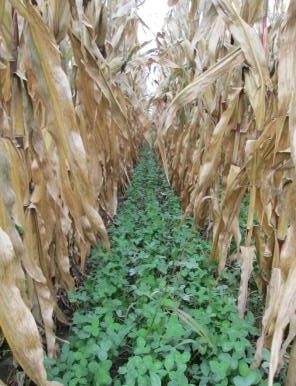Legume cover crops, such as red, berseem, and crimson clover, are cover crops that have the clearest short term economic benefit to farmers by supplying nitrogen (N). These plants are rich in N (i.e. have a low C:N ratio) compared to other cover crops like rye or radish. When the clover biomass decomposes, it releases N into the soil, and at the time of peak N uptake of a corn crop. This means that reductions can be made to the amount of in-season N fertilizer application, saving money and reducing the potential for N leaching to tile drains or groundwater resources. No other type of cover crop has shown such a consistent short-term economic benefit.
For farmers with winter wheat in their crop rotation, use of clover species as cover crops provide clear benefits to the corn phase of production in the rotation. Red clover is a popular cover crop that can be “frost seeded” into winter wheat in March or April. This technique involves overseeding red clover at a rate of 12 lb/ac when the soil is dry and has a little bit of cracking. The red clover establishes in the understory of the growing winter wheat crop (Figure 1) and grows quickly following winter wheat harvest. Because of the large amount of biomass that can accumulate, we have been terminating the red clover in the fall. You can let it grow into the spring (it will not winter kill) if you would like to “grow” more N, but timeliness of field operations need to be considered. Research trials have shown that the N credit (or to phrase another way – the fertilizer replacement value) of the red clover can be 45 to 90 lb/ac. It is clear there is an N credit to be taken, but the specific amount appears to be quite variable across growing seasons.

Another option is to plant berseem or crimson clover following winter wheat harvest. In research trials in Sheboygan County, these clovers have been shown to be quite beneficial. Crimson clover has at least a 45 lb/ac N credit, with berseem clover having a lower range (15 to 40 lb-N/ac). Berseem clover, however, has resulted in corn yield gains of 13-15 bu/ac. Demonstrating the dual benefit of the clovers on the subsequent corn crop.
Previous demonstration trials have shown that red clover establishes quite well when interseeded into standing corn (drill seeded at the V4-V5 growth stage) (Figure 2). Current research, funded by the Wisconsin Fertilizer Research Council, is evaluating what the N credit would be for the next year’s corn crop, as well as making sure there are no negative effects on the current corn crop. If successful, this practice could serve to both reduce inorganic fertilizer requirements and improve biological aspects of soil health (which are sometimes lacking in continuous corn systems). The improvement in soil biology could also be beneficial to corn yield.

Overall, it is clear that clovers have tremendous benefit to our corn-based cropping systems. Unfortunately, it requires winter wheat in rotation for it to be easy to get the clover planted in time to get a lot of growth. We have a bit more to learn on the optimum agronomic practices to make sure red clover can grow well when interseeded. As additional on-farm trials are conducted, look for updates at field days and UWEX conferences. In the meantime, I highly recommend playing around with clovers on your fields (staring small to start of course).
Dr. Ruark is an Associate Professor at UW-Madison in the Department of Soil Science focusing on soil fertility and nutrient management. He serves as the Faculty Advisor for the UW-Discovery Farms program. You can learn more about his team and research by visiting http://ruarklab.soils.wisc.edu/.
- How can we get more clover cover crops planted in our fields? - June 12, 2017